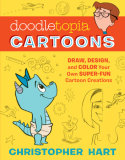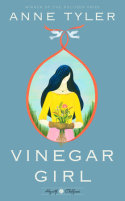
Christopher Hart's book, Doodletopia Cartoons is a quasi how-to book about drawing cartoons. It is divided into ten sections each featuring cartoons emphasizing different aspects of cartooning followed by drawing exercises to practice said concept.
What do I like about this book? The art. The cartoons have a really fun retro look, and they are well done. The humor. Mr. Hart is a funny man. He promises that completion of the first chapter will enable you to run for public office and be elected president (p.11), makes unflattering personal remarks about his likely fictitious family (We're talking about you, Aunt Ethel, p.48) , and shares his personal opinion about the Hipster look (pp. 105-107). Pointers. Mr. Hart has helpful advice, e.g. "A small chest with slightly wider hips gives a humorous look to thin characters. (p.50)."
What don't I like about this book? In section 3, Draw the Other Half, Mr. Hart talks about symmetry. I disagree that this is what he's taking about. I think the real concept at issue here is proportion. His pictures are not symmetrical. Although I am giving him kudos for drawing his eyes the same size and shape. It's the other features that are asymmetrical. In his drawing exercises he gives a prompt, the completed picture, and a facing page with half of the picture for the artist to complete. Some of the prompts differ slightly from the half-cartoon, so it can be a minor adjustment if you're basing it off of the prompt. On a whim I completed one of the exercises completely symmetrically...it doesn't work out great. Not horrible. Just not great. I did think the exercises were really excellent practice for getting the proportions right - something I struggle with. My next issue is that I would have preferred maybe a little bit more instruction. Mr. Hart sometimes issues directives that aren't explained; the small chest/wide hips for thin characters is clearly illuminated, but "Draw the eyes on a tilted angle (p.38.)" and "Draw the hair flat on the sides but bumpy at the top (p.34)." work to good effect on the picture, but why and when?
I was going to flat out not recommend this book. Mr. Hart is witty, his art is great, and he has some helpful pointers. But his book, which is about two steps away from being a one-time use book, is retailing for about $17.00. And although I like the book, for the most part, I think that price point is too high. When you stop and think about the time and expertise that were obviously put into this book, of course it seems completely reasonable. But what we're really looking at here is our budgets, not the artist's. For me to pay $17.00 for a paperback, it's going to be a special occasion or someone who's work I'm obsessed with (like Ben Hatke, but we'll talk about that later.). I give this one caveat: there are about 160 pages in this book. It is the length alone that makes me say, maybe you would be okay forking over the money. The other reason you might pay that is that a number of cartooning books ( many of them written by Christopher Hart) are similarly priced. But as I read and drew in this book, I kept itching to pull out another book. Which I finally did, and confirmed that, yes, I really do love that book. So here is my honest recommendation: Buy the book if you want, but seriously consider additionally or alternatively buying Action Cartooning by Ben Caldwell. It is an amazing resource for anyone truly interested in cartooning. Also take to heart Mr. Caldwell's recommendation that you purchase Atlas of Human Anatomy for the Artist by Stephen Rogers Peck.
I received this book from Blogging for Books in exchange for my review. This is my honest opinion about the book.
